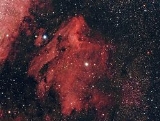
Pelican Nebula
Encyclopedia
The Pelican Nebula is an H II region
associated with the North America Nebula
in the constellation
Cygnus
. The gaseous contortions of this emission nebula
bear a resemblance to a pelican
, giving rise to its name. The Pelican Nebula is located nearby first magnitude
star Deneb
, and is divided from its more prominent neighbour, the North America Nebula, by a molecular cloud
filled with dark dust
.
The Pelican is much studied because it has a particularly active mix of star formation
and evolving gas clouds. The light from young energetic stars is slowly transforming cold gas to hot and causing an ionization
front gradually to advance outward. Particularly dense filaments of cold gas are seen to still remain, and among these are found two jets emitted from the Herbig–Haro object 555. Millions of years from now this nebula might no longer be known as the Pelican, as the balance and placement of stars and gas will leave something that appears completely different.
H II region
An H II region is a large, low-density cloud of partially ionized gas in which star formation has recently taken place. The short-lived, blue stars forged in these regions emit copious amounts of ultraviolet light, ionizing the surrounding gas...
associated with the North America Nebula
North America Nebula
The North America Nebula is an emission nebula in the constellation Cygnus, close to Deneb . The remarkable shape of the emission nebula resembles that of the continent of North America, complete with a prominent Gulf of Mexico...
in the constellation
Constellation
In modern astronomy, a constellation is an internationally defined area of the celestial sphere. These areas are grouped around asterisms, patterns formed by prominent stars within apparent proximity to one another on Earth's night sky....
Cygnus
Cygnus (constellation)
Cygnus is a northern constellation lying on the plane of the Milky Way. Its name is the Latinized Hellenic word for swan. One of the most recognizable constellations of the northern summer and autumn, it features a prominent asterism known as the Northern Cross...
. The gaseous contortions of this emission nebula
Emission nebula
An emission nebula is a cloud of ionized gas emitting light of various colors. The most common source of ionization is high-energy photons emitted from a nearby hot star...
bear a resemblance to a pelican
Pelican
A pelican, derived from the Greek word πελεκυς pelekys is a large water bird with a large throat pouch, belonging to the bird family Pelecanidae....
, giving rise to its name. The Pelican Nebula is located nearby first magnitude
Magnitude
Magnitude Is A Part Of An EarthquakesMagnitude may refer to:In mathematics:*Magnitude , the relative size of a mathematical object*Magnitude , a term for the size or length of a vector...
star Deneb
Deneb
Deneb is the brightest star in the constellation Cygnus and one of the vertices of the Summer Triangle. It is the 19th brightest star in the night sky, with an apparent magnitude of 1.25. A blue-white supergiant, Deneb is also one of the most luminous nearby stars...
, and is divided from its more prominent neighbour, the North America Nebula, by a molecular cloud
Molecular cloud
A molecular cloud, sometimes called a stellar nursery if star formation is occurring within, is a type of interstellar cloud whose density and size permits the formation of molecules, most commonly molecular hydrogen ....
filled with dark dust
Cosmic dust
Cosmic dust is a type of dust composed of particles in space which are a few molecules to 0.1 µm in size. Cosmic dust can be further distinguished by its astronomical location; for example: intergalactic dust, interstellar dust, interplanetary dust and circumplanetary dust .In our own Solar...
.
The Pelican is much studied because it has a particularly active mix of star formation
Star formation
Star formation is the process by which dense parts of molecular clouds collapse into a ball of plasma to form a star. As a branch of astronomy star formation includes the study of the interstellar medium and giant molecular clouds as precursors to the star formation process and the study of young...
and evolving gas clouds. The light from young energetic stars is slowly transforming cold gas to hot and causing an ionization
Ionization
Ionization is the process of converting an atom or molecule into an ion by adding or removing charged particles such as electrons or other ions. This is often confused with dissociation. A substance may dissociate without necessarily producing ions. As an example, the molecules of table sugar...
front gradually to advance outward. Particularly dense filaments of cold gas are seen to still remain, and among these are found two jets emitted from the Herbig–Haro object 555. Millions of years from now this nebula might no longer be known as the Pelican, as the balance and placement of stars and gas will leave something that appears completely different.

